-
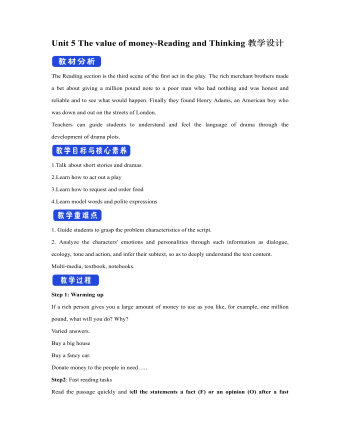
新人教版高中英语必修3Unit 5 The value of money-Reading and Thinking教学设计二
? Could you offer me some kind of work here?? I don’t want your charity, I just want an honest job.? Careless: I landed in Britain by accident.Step 7:Consolidation.? Find Henry? Roderick and Oliver were I .making a bet when they saw Henry, a poor young man. ? Know Henry? About a month ago, Henry was sailing and later he found himself carried out to sea by a strong wind. Fortunately, he 2.was spotted by a ship. And it was the ship that brought him to 3.England? Offer money to Henry ? Oliver and Roderick gave Henry a letter and told him that there was money in it. They 4.persuaded him to accept it, and made him 5.promise that it wouldn't be opened until 2 o'clock.Step 8:Language pointsa large amount of: a large quantity of; a great deal ofe.g. They bought a large amount of furniture before they moved their new house.make a bet: make an arrangement to risk money, etc. on an event of which the result is doubtful.e.g. We made a bet on the result of the match.permit sb to do something: allow somebody to do somethinge.g. My mother doesn’t permit me to ride in the street after it rained.by accident: as a result of chancee.g. I only found it by accident.stare at: look at somebody or something with the eyes wide open in a fixed gaze( in astonishment, wonder, fear, etc)to be honest: to tell you the truth; to be franke.g. To be honest, I don’t think we have a chance of winning.Step7 Homework:What do you think will happen to Henry? Will the bank-note help him or get him into trouble?

新人教版高中英语必修3Unit 5 the value of money-Reading For Writing教学设计一
【参考范文】Narrator:(Henry is smiling as he leaves the restaurant. As he is walking down the street, he sees a sign for a place that cuts hair. He decides to get it cut. )H=Henry;B=Barber;R=rude manH:Good afternoon, I'd like to get a cut, if I may. (The barber looks at Henry's hair and continues cutting another man's hair. )Er, I'd really like a haircut. As you can see it's much too long. B:(in a rude manner) Yes, I can see that. Indeed, I can. H:Fine, well I'll have a seat then. (He sits in one of the barber's chairs. The barber turns to look at Henry. )B:It's quite expensive here, you know!Are you sure you can afford it?H:Yes. I think so. (In comes the rude man. )R:Hey you there. I need a haircut quickly. Can you do me straightaway?B:All right, then, get in the chair and I'll see what I can do. R:Thank you. (sits down in one of the barber's chairs)H:Excuse me, but I was here first. Aren't you going to do my hair first?B:This man's in a hurry. H:Well so am I!I insist that you cut my hair first. B:OK, but I'll have to be quick. This gentleman is waiting. H:Thank you. (They both become quiet. After his hair is cut, the barber tells Henry how much he must pay. Henry shows the barber the bank note. )B:Why, Mr . . . (looks shocked)H:Adams. Henry Adams. I'm sorry, I don't have any change. R:You're that Mr Adams! Well,I'm glad I waited or I might never have known it was you. B:Why, Mr Adams, please don't worry!(wearing a big smile) Nothing to worry about!Nothing at all!Please come back any time, even if you only need too little hairs cut!It will be my honour to serve you!

新人教版高中英语选修2Unit 1 Science and Scientists-Discovering useful structures教学设计
The grammatical structure of this unit is predicative clause. Like object clause and subject clause, predicative clause is one of Nominal Clauses. The leading words of predicative clauses are that, what, how, what, where, as if, because, etc.The design of teaching activities aims to guide students to perceive the structural features of predicative clauses and think about their ideographic functions. Beyond that, students should be guided to use this grammar in the context apporpriately and flexibly.1. Enable the Ss to master the usage of the predicative clauses in this unit.2. Enable the Ss to use the predicative patterns flexibly.3. Train the Ss to apply some skills by doing the relevant exercises.1.Guide students to perceive the structural features of predicative clauses and think about their ideographic functions.2.Strengthen students' ability of using predicative clauses in context, but also cultivate their ability of text analysis and logical reasoning competence.Step1: Underline all the examples in the reading passage, where noun clauses are used as the predicative. Then state their meaning and functions.1) One theory was that bad air caused the disease.2) Another theory was that cholera was caused by an infection from germs in food or water.3) The truth was that the water from the Broad Street had been infected by waste.Sum up the rules of grammar:1. 以上黑体部分在句中作表语。2. 句1、2、3中的that在从句中不作成分,只起连接作用。 Step2: Review the basic components of predicative clauses1.Definition

新人教版高中英语选修2Unit 1 Science and Scientists-Using langauge教学设计
This happens because the dish soap molecules have a strong negative charge, and the milk molecules have a strong positive charge. Like magnets, these molecules are attracted to each other, and so they appear to move around on the plate, taking the food coloring with them, making it look like the colors are quickly moving to escape from the soap.Listening text:? Judy: Oh, I'm so sorry that you were ill and couldn't come with us on our field trip. How are you feeling now? Better?? Bill: Much better, thanks. But how was it?? Judy: Wonderful! I especially liked an area of the museum called Light Games.it was really cool. They had a hall of mirrors where I could see myself reflected thousands of times!? Bill: A hall of mirrors can be a lot of fun. What else did they have?? Judy: Well, they had an experiment where we looked at a blue screen for a while, and then suddenly we could see tiny bright lights moving around on it. You'll never guess what those bright lights were!? Bill: Come on, tell me!? Judy: They were our own blood cells. For some reason, our eyes play tricks on us when we look at a blue screen, and we can see our own blood cells moving around like little lights! But there was another thing I liked better. I stood in front of a white light, and it cast different shadows of me in every color of the rainbow!? Bill: Oh, I wish I had been there. Tell me more!? Judy: Well, they had another area for sound. They had a giant piano keyboard that you could use your feet to play. But then, instead of playing the sounds of a piano, it played the voices of classical singers! Then they had a giant dish, and when you spoke into it, it reflected the sound back and made it louder. You could use it to speak in a whisper to someone 17 meters away.? Bill: It all sounds so cool. I wish I could have gone with you? Judy: I know, but we can go together this weekend. I'd love to go there again!? Bill: That sounds like a great idea!

新人教版高中英语选修2Unit 3 Food and Culture-Reading and thinking教学设计
The discourse explores the link between food and culture from a foreign’s perspective and it records some authentic Chinese food and illustrates the cultural meaning, gerography features and historic tradition that the food reflects. It is aimed to lead students to understand and think about the connection between food and culture. While teaching, the teacher should instruct students to find out the writing order and the writer’s experieces and feelings towards Chinese food and culture.1.Guide the students to read the text, sort out the information and dig out the topic.2.Understand the cultural connotation, regional characteristics and historical tradition of Chinese cuisine3.Understand and explore the relationship between food and people's personality4.Guide the students to use the cohesive words in the text5.Lead students to accurately grasp the real meaning of the information and improve the overall understanding ability by understanding the implied meaning behind the text.1. Enable the Ss to understand the structure and the writing style of the passage well.2. Lead the Ss to understand and think further about the connection between food and geography and local character traits.Step1: Prediction before reading. Before you read, look at the title, and the picture. What do you think this article is about?keys:It is about various culture and cuisine about a place or some countries.
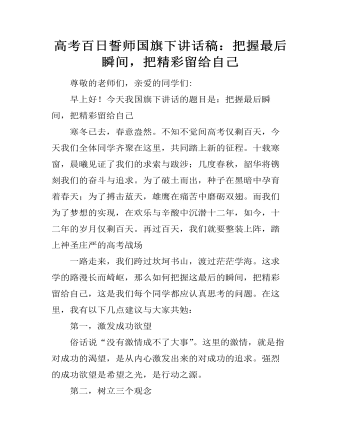
高考百日誓师国旗下讲话稿:把握最后瞬间,把精彩留给自己
尊敬的老师们,亲爱的同学们:早上好!今天我国旗下讲话的题目是:把握最后瞬间,把精彩留给自己寒冬已去,春意盎然。不知不觉间高考仅剩百天,今天我们全体同学齐聚在这里,共同踏上新的征程。十载寒窗,晨曦见证了我们的求索与跋涉;几度春秋,韶华将镌刻我们的奋斗与追求。为了破土而出,种子在黑暗中孕育着春天;为了搏击蓝天,雄鹰在痛苦中磨砺双翅。而我们为了梦想的实现,在欢乐与辛酸中沉潜十二年,如今,十二年的岁月仅剩百天。再过百天,我们就要整装上阵,踏上神圣庄严的高考战场一路走来,我们跨过坎坷书山,渡过茫茫学海。这求学的路漫长而崎岖,那么如何把握这最后的瞬间,把精彩留给自己,这是我们每个同学都应认真思考的问题。在这里,我有以下几点建议与大家共勉:第一,激发成功欲望俗话说“没有激情成不了大事”。这里的激情,就是指对成功的渴望,是从内心激发出来的对成功的追求。强烈的成功欲望是希望之光,是行动之源。第二,树立三个观念
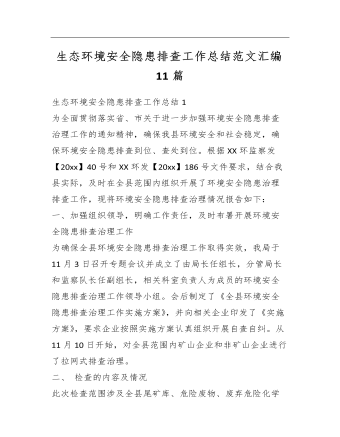
生态环境安全隐患排查工作总结范文汇编11篇
二、校园文化本学期,我校在县教体局的正确领导和亲切关怀下,教学大楼已经交付使用,操场已经全部硬化,并以开始铺设塑胶,校园四周也已按照构想进行了布置。富有青云小学文化特色的现代化校园已基本形成。1、加强校园文化建设的组织领导。校园文化建设是提升教育质量、打造办学特色、实现办学理念不可或缺的前提,只有拥有文化的支撑、方能体现学校的内涵,因此我校高度重视校园文化建设,坚持传承和弘扬我校悠久灿烂的历史文化,以校园现代化设施为依托,努力打造实施素质教育与传统文化教育为主要亮点的学校名片。为了做好校园文化建设工作,我校成立了以校长为核心,中层领导和班主任教师参与的校园文化建设工作领导小组,制定了校园文化建设实施方案,并认真组织实施。2、开展各种活动,焕发校园生机。①坚持了每周一升国旗和国旗下的讲话制度,这一活动已成为我校的一道亮丽风景。
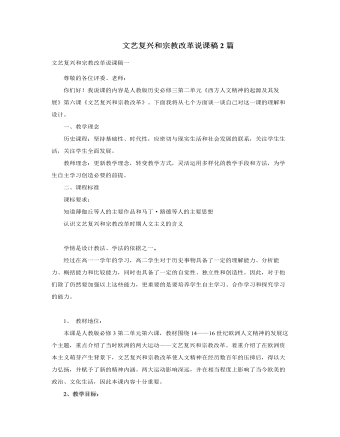
人教版高中历史必修3文艺复兴和宗教改革说课稿2篇
师:在科学发展过程中,前一个理论体系的不完善之处,往往是新的研究和新的发现的突破口。开普勒之后,意大利天文学家伽利略创制了天文望远镜,用更加精确的观察继续发展和验证哥白尼创立的新天文学理论。除了用望远镜进行天文观察以外,伽利略还开始进行自然科学的实验研究,哪位同学能给大家讲一讲伽利略在比萨斜塔上所作的关于物体自由下落的实验?生:(讲述这一实验)师:所以,伽利略在科学方面更加重要的贡献是奠定了近代实验科学的基础。(2)实验科学和唯物主义师:伽利略从实践上开辟了实验科学的方法,而英国唯物主义哲学家培根则从理论上阐述了实验科学的方法——归纳法。培根和伽利略同被称为实验科学之父,培根还有一句影响深刻的名言:“知识就是力量”,表明了他注重知识,尊崇科学的精神。我们再来概括一下意大利哲学家布鲁诺的唯物主义思想,是否有同学可以简述布鲁诺的生平事迹?
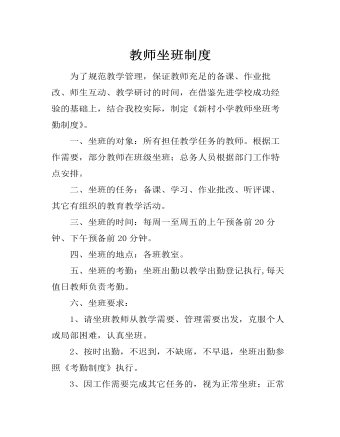
教师坐班制度
二、坐班的任务:备课、学习、作业批改、听评课、其它有组织的教育教学活动。 三、坐班的时间:每周一至周五的上午预备前20分钟、下午预备前20分钟。 四、坐班的地点:各班教室。 五、坐班的考勤:坐班出勤以教学出勤登记执行,每天值日教师负责考勤。 六、坐班要求: 1、请坐班教师从教学需要、管理需要出发,克服个人或局部困难,认真坐班。
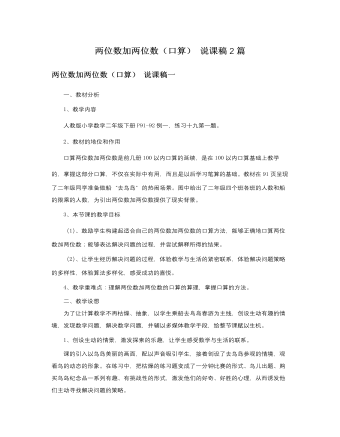
人教版新课标小学数学二年级下册两位数加两位数(口算)说课稿2篇
(四)、课堂总结、体验成功引导学生对所学知识、学习方法、学习结果、情感等进行全面总结,让学生体验学习的成功感,同时,进一步系统、完善知识结构。总之,本课的教学设计力求体现“以学生为本”的教学理念,具体体现在以下几个方面:(一)、创设生动的情景,激发探索的乐趣,让学生感受数学与生活的联系。课的引入以一幅学生经常接触的,喜闻乐见的购买玩具这一题材为切入点。在练习设计中,改变枯燥抽象的数字计算练习,选取了一组寓有童趣的素材。它们以丰富多彩的呈现方式深深地吸引着学生,使他们认识到现实生活中蕴含着大量的数学信息,使学生感到有趣、有挑战性,激发他们好奇,好胜的心理,从而诱发他们去主动寻求解决问题的策略,同时体验到数学与生活的联系。
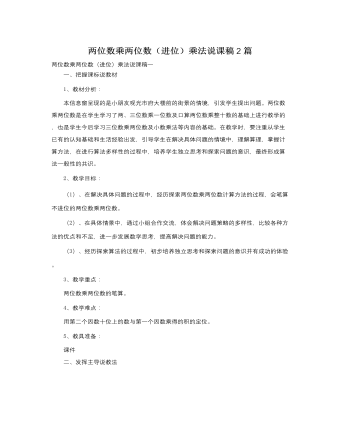
人教版新课标小学数学三年级下册两位数乘两位数(进位)乘法说课稿2篇
(一)创设情境,提出问题:学生的学习动机和求知欲不会自然涌现,它取决于教师所创设的学习情境,而兴趣是最好的老师,因此,在课的一开始,我设计了“今天我们再去街心公园看一看”这一情境:出示情境图:你看到了什么信息,你能提出什么数学问题?(板书)学生提出很多问题。设计意图:数学来源于生活,有趣的生活情境,激发学生好奇心和强烈的求知欲,让学生在生动具体的情境中学习数学,从而使教材与学生之间建立相互包容、相互激发的关系。让学生既认识了自身,又大胆而自然地提出猜想。(二)、探索新知解决问题“教师为主导,学生为主体,探究为主线”的三为主原则“保护环境”花坛一共用了多少盆花?怎样列式?
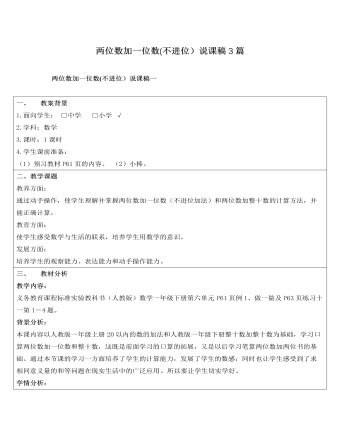
人教版新课标小学数学一年级下册两位数加一位数(不进位)说课稿3篇
一、说教材《两位数加一位数的进位加法》是人教版义务教育课程标准实验教科书一年级下册P62“两位数加一位数的进位加法”,本课是在两位数加一位数和整十数的基础上进行教学的。在本节课中,通过生活情境图,引入两位数加一位数的进位加法,并使学生在解决实际问题的过程中,进一步体会加法的意义,鼓励学生提出问题并解决问题,要让学生在独立思考的基础上,经历与他人交流的过程,探索并掌握两位数加一位数进位加法的计算方法,并能正确地计算,加强动手操作,探索计算方法,体会算法的多样性。根据本节课在教材中的地位和作用,依据小学数学课程标准和孩子们已有的认知水平,我把本节课的教学目标定为:1、知识与技能在解决实际问题的过程中,进一步体会加法的意义,探索并掌握两位数加一位数进位加法的计算方法。
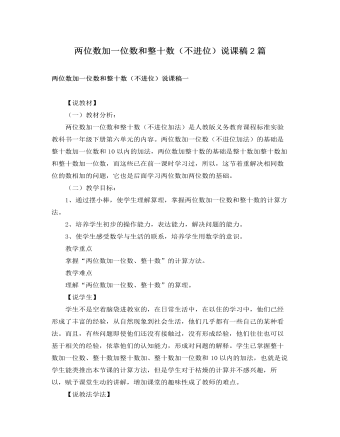
人教版新课标小学数学一年级下册两位数加一位数和整十数(不进位)说课稿2篇
(二)创设情境,探索新知。1、创设情境,激发兴趣。小白兔和小熊要坐公交车去公园,他们来到公交公司,先后看到公交公司有一边说一边课件出示课件,请同学们仔细观察,把你从图上看到的物品和读出的数据告诉老师和其他同学。你能根据这些信息提出不同的数学问题吗?再从同学们提出的众多问题中选择两个具有代表性的问题来列式和计算。课件出示主题图下列两个问题:指名说出两个问题的算式分别是什么,明确45 + 30和45 + 3是两位数加一位数和两位数加整十数的加法算式,引出课题——两位数加一位数和整十数(不进位)这一层次从学生熟悉的生活情境出发,选择学生熟悉的旅游,让学生自己发现、提出有关的数学问题,从而主动的解决问题。这里通过创造出生动的生活情境来提取例题,符合学生的年龄、认知特征,既激发了学生的学习兴趣,又使学生感受到数学与生活的密切联系,容易为学生所感知,所接受。
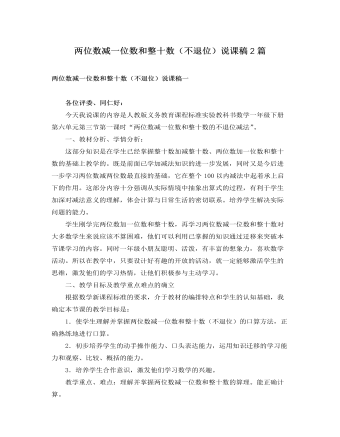
人教版新课标小学数学一年级下册两位数减一位数和整十数(不退位)说课稿2篇
3、教学目标及教学重点难点根据课标的要求,介于教材的特点和学生实际,我确定本节课的教学目标是:(1)、知识与技能:让学生经历探索两位数减一位数和整十数(不退位)的计算方法的过程,掌握计算方法,能正确地口算。(2)、过程与方法:让学生经历自主探索、动手操作、合作交流等方式获得新知的过程,积累数学活动的经验,体会数学知识与日常生活的密切联系,增强应用意识。 (3)、情感态度与价值观:进一步培养学生学习数学的热情,以及积极思考、动手实践并与同学合作学习的态度。其中,掌握两位数减一位数和整十数(不退位)的口算方法是重点,理解算理,把握两位数减一位数与两位数减整十数在计算过程中的相同点与不同点是难点。
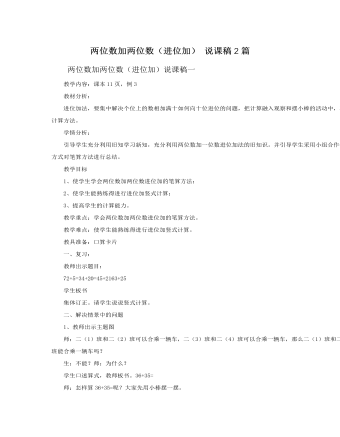
人教版新课标小学数学二年级上册两位数加两位数(进位加) 说课稿2篇
一、说教材:本课时主要的内容就是让学生在情境中掌握两位数加两位数的进位加法计算,让学生通过尝试和探索出多种算法,体验多种算法,然后比较出最好的算法。教学目标:1、通过具体的情境使学生更一步的理解加法的意义和提高学生的估算意识。2、通过学生的合作学习从而能探讨出多种计算两位数减两位退位减法的方法。3、培养学生的数学口语表达能力,提高学生的学习兴趣。4、掌握两位数加两位数(进位加)竖式的写法。重点:(1)通过学生的合作学习从而能探讨出多种计算两位数减两位退位减法的方法。(2)掌握笔算加法的计算法则。难点:对多样化算法进行优化,达到正确完成计算。发展学生的估算意识、和探究意识和解决实际问题的能力。二、说教法:组织学生在前面计算的基础上,自主探索出两位数加两位(进位加)的计算方法,并通过交流、讨论,达到对算法的优化,在通过“试一试”、“算一算”、“想一想”等形式达到知识的掌握。
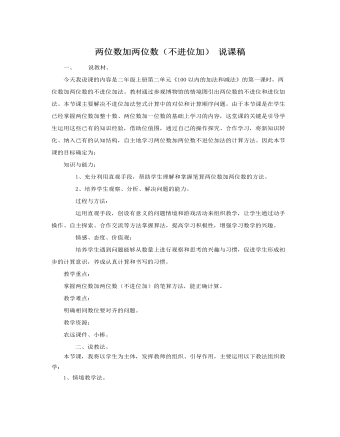
人教版新课标小学数学二年级上册两位数加两位数(不进位加) 说课稿
今天我说课的内容是二年级上册第二单元《100以内的加法和减法》的第一课时,两位数加两位数的不进位加法。教材通过参观博物馆的情境图引出两位数的不进位和进位加法。本节课主要解决不进位加法竖式计算中的对位和计算顺序问题。由于本节课是在学生已经掌握两位数加整十数、两位数加一位数的基础上学习的内容,这堂课的关键是引导学生运用这些已有的知识经验,借助位值图,通过自己的操作探究、合作学习,将新知识转化、纳入已有的认知结构,自主地学习两位数加两位数不进位加法的计算方法。因此本节课的目标确定为:知识与能力:1、充分利用直观手段,帮助学生理解和掌握笔算两位数加两位数的方法。2、培养学生观察、分析、解决问题的能力。过程与方法:运用直观手段,创设有意义的问题情境和游戏活动来组织教学,让学生通过动手操作、自主探索、合作交流等方法掌握算法,提高学习积极性,增强学习数学的兴趣。
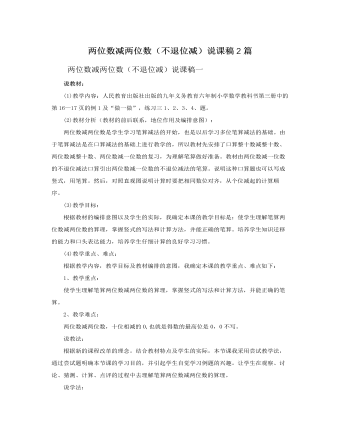
人教版新课标小学数学二年级上册两位数减两位数(不退位减)说课稿2篇
说教材:(1)教学内容:人民教育出版社出版的九年义务教育六年制小学数学教科书第三册中的第16—17页的例1及“做一做”,练习三1、2、3、4、题。(2)教材分析(教材的前后联系,地位作用及编排意图):两位数减两位数是学生学习笔算减法的开始,也是以后学习多位笔算减法的基础。由于笔算减法是在口算减法的基础上进行教学的,所以教材先安排了口算整十数减整十数、两位数减整十数、两位数减一位数的复习,为理解笔算做好准备。教材由两位数减一位数的不退位减法口算引出两位数减一位数的不退位减法的笔算。说明这种口算题也可以写成竖式,用笔算。然后,对照直观图说明计算时要把相同数位对齐,从个位减起的计算顺序。(3)教学目标:根据教材的编排意图以及学生的实际,我确定本课的教学目标是:使学生理解笔算两位数减两位数的算理,掌握竖式的写法和计算方法,并能正确的笔算。培养学生知识迁移的能力和口头表达能力,培养学生仔细计算的良好学习习惯。
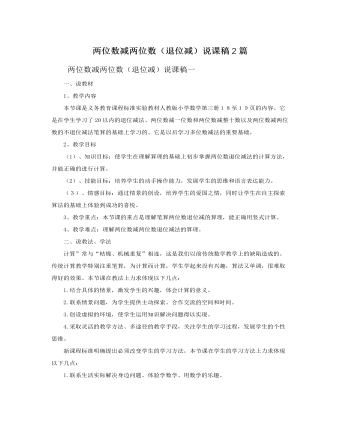
人教版新课标小学数学二年级上册两位数减两位数(退位减)说课稿2篇
一、说教材1、教学内容本节课是义务教育课程标准实验教材人教版小学数学第三册18至19页的内容。它是在学生学习了20以内的退位减法、两位数减一位数和两位数减整十数以及两位数减两位数的不退位减法笔算的基础上学习的。它是以后学习多位数减法的重要基础。2、教学目标(1)、知识目标:使学生在理解算理的基础上初步掌握两位数退位减法的计算方法,并能正确的进行计算。(2)、技能目标:培养学生的动手操作能力,发展学生的思维和语言表达能力。(3)、情感目标:通过情景的创设,培养学生的爱国之情,同时让学生在自主探索算法的基础上体验到成功的喜悦。3、教学重点:本节课的重点是理解笔算两位数退位减的算理,能正确用竖式计算。4、教学难点:理解两位数减两位数退位减法的算理。
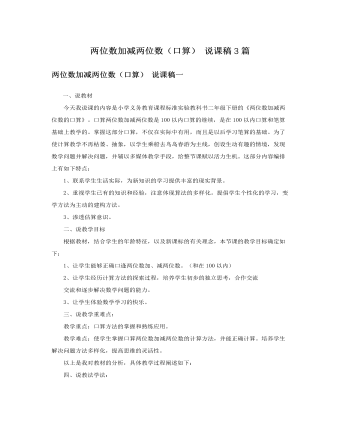
人教版新课标小学数学二年级下册两位数加减两位数(口算)说课稿3篇
二、说教学目标1、结合具体情境进一步理解加减法的意义,能正确口算得数是百以内数的两位数加减法。2、能利用所学知识,在教师的指导下提出并解决简单的实际问题,了解同一问题可以用不同的方法解决。3、经历与他人交流各自计算方法的过程,体验解决问题策略的多样性,感受学数学、用数学的乐趣。三、说教法、学法教法:为了使学生掌握好百以内的两位数加减两位数的口算这部分知识,达到以上教学目的,突破以上教学重难点,我采用了迁移法、引导法、讲解法、联系法、自主探索法来进行教学。学法:通过本课的学习,使学生学会利用旧知构建新知的方法、合作探究的方法,调动学生主动探索的积极性。四、说教学过程(一)创设情景、导入新课1、谈话:同学们,大千世界无奇不有。我们所处的人类的社会是由一个个担任不同工作的人所组成的,而和我们生活密切相关的蜜蜂也跟人类一样,它们生活在一个蜜蜂王国里,今天我们就一起到那里了解一下蜜蜂的生活吧。
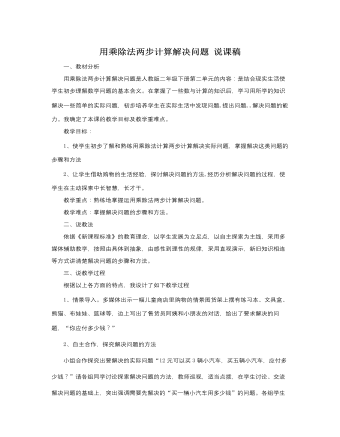
人教版新课标小学数学二年级下册用乘除法两步计算解决问题说课稿
例2是面包房买卖面包的情境。解决问题的重点是学会使用小括号列综合算式,并了解小括号的作用。通过学生熟悉的购买面包的情境,解决“还剩多少个”这个实际问题。仍然可以引导学生从不同的角度思考问题,启发列式为54-8-22或为54-(8+22)。第二种解法的综合算式,教材中特别强调“如果写成一个算式,应该使用小括号”,并明确“计算时先算小括号里面的”。因为是初次在列式时需要使用小括号,如果学生产生疑问,教师可组织学生通过回顾旧知,利用现实情境,明确使用小括号的必要性及使用方法。教学例2时可以采用与例1相似的教学方式。首先让学生观察下页图,也可以利用电教媒体创设情境,由学生提出问题,并启发学生思考如何解决。让学生充分交流研讨,畅谈自己的想法,然后着重说明解决问题的思路。列式计算时可以先分步列式,同时强调两种列式方法的内在联系,列综合算式时着重说明使用小括号的目的。


